As an alternative to filament 3D printers, resin printers generally print smaller objects but at much higher detail levels. Resin printers that use photo-sensitive liquid plastics are a relatively new phenomenon but one that has rapidly become the norm for those in the modeling and tabletop gaming space. The first commercial resin printers were created for dental and jewelry use, but today, more resin is bought to create undead armies and elaborate sculptures.
While it is possible to solidify the resin using lasers, most retail printers use an ultraviolet light source masked by an LCD screen. The quality of the resulting parts depends on the polymer used (epoxy resins, acrylic resins, and polyurethane), the time of exposure, the movement of the build platform, and the resolution of the masking screen. One quirk is that resin printers with larger build volumes often generate lower resolution parts because a 4K screen, for example, on a small printer results in smaller voxels (the smallest addressable 3D pixel) than an 8K panel on a larger printer.
Buyers need to consider how large the parts they want to print will be or if they wish to print multiple items on a larger print bed. The speed of printing and the inclusion of special features, such as resin level management in the vat, air filtration, and heaters, invariably increase costs. Some printers are also made to work with special high-speed resins, but these often trade print quality for quicker results.
This list includes several great resin printers that vary wildly in cost and capabilities. Among these, you should be able to find the perfect resin printer for your needs.
Top solidifying resin printers
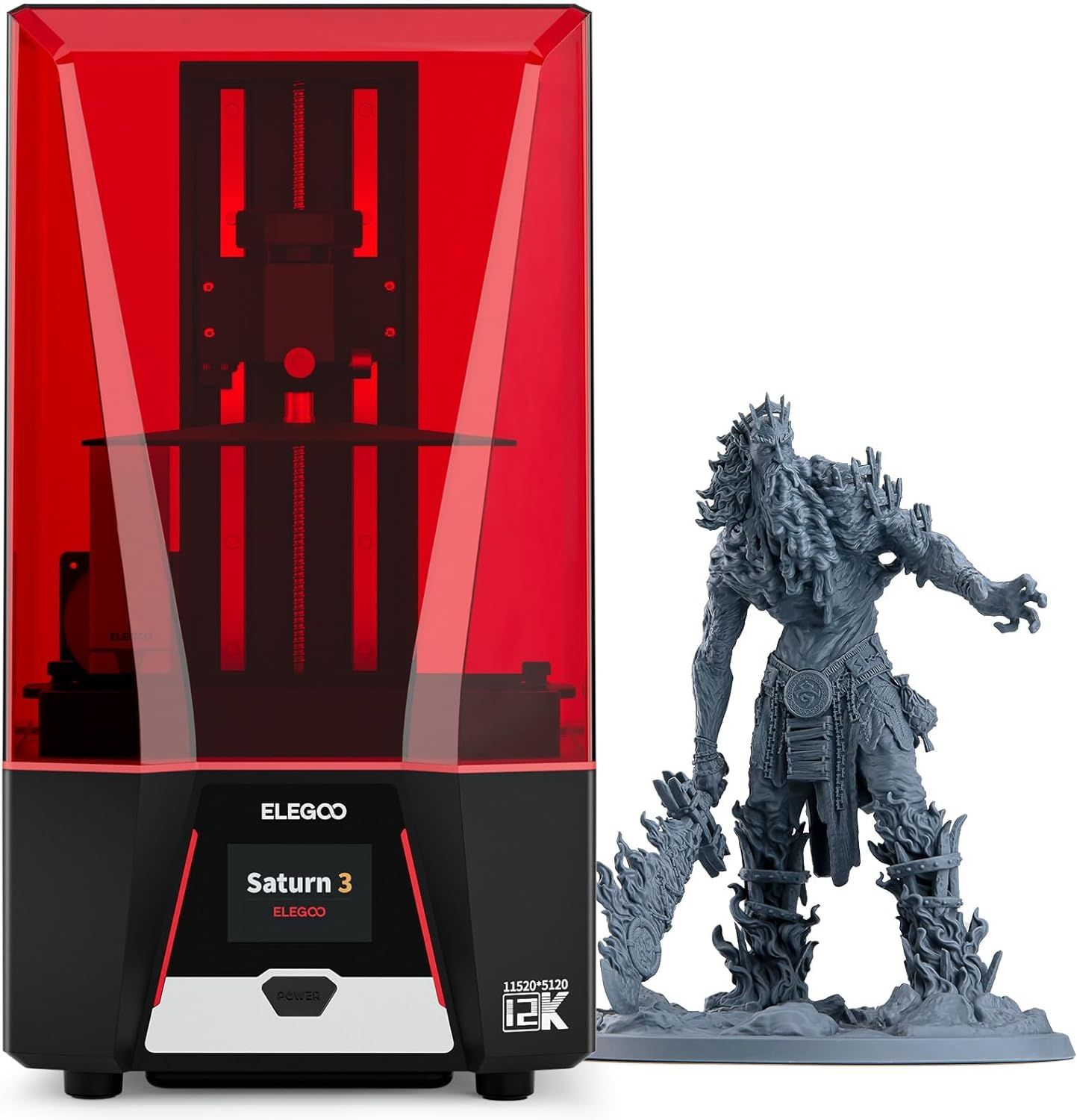
Elegoo Saturn 3 12K
Best overall
Medium-volume workhorse
$369 $450 Save $81
The Elegoo Saturn 3 is a mid-sized resin printer with a 10-inch 12K mono screen that allows a resolution of 19×24μm for remarkably crisp prints and short exposure times. Developed from the original Elegoo Saturn and Saturn 2s, the Saturn 3 is the perfect companion for artists who need a reliable workhorse printer.
- Well-made
- Decent print volume for resin
- Inexpensive for the quality of output
- Lacks any resin management
- LCD panel only lasts 2,000 hours
The Elegoo Saturn was one of the first large-format resin printers to get under the $500 price point, and its success has spawned the Saturn S, Saturn 2 8K, and Saturn 3 series. The Saturn 3 12K model offers an expanded print volume, faster printing, and shorter exposure times than its predecessors, but comes at an affordable cost.
It has a print volume of 218.88 x 122.88 x 250mm; that’s enough capacity to print some substantial sculptures, and with a vertical print speed of 70mm per hour, it can print quickly. With a large resin vat and print area, the consistency of exposure is important, and the Saturn 3 12K uses a COB light source and Fresnel collimating lens to deliver 90% uniformity over the vat, resulting in predictable prints.
Elegoo was one of the first printer makers to consider reducing the resin fumes, and this one comes with an integrated USB-powered air purification system that can be upgraded to the new Elegoo Mars MATE air purifier, quoted as removing 95% of VOCs from the air.
With a highly competitive price for a resin printer of this scale, the only caveat to the Saturn 3 is that, like many in its class, the 12K LCD only has a working life of 2,000 hours before this $150 item needs replacing.
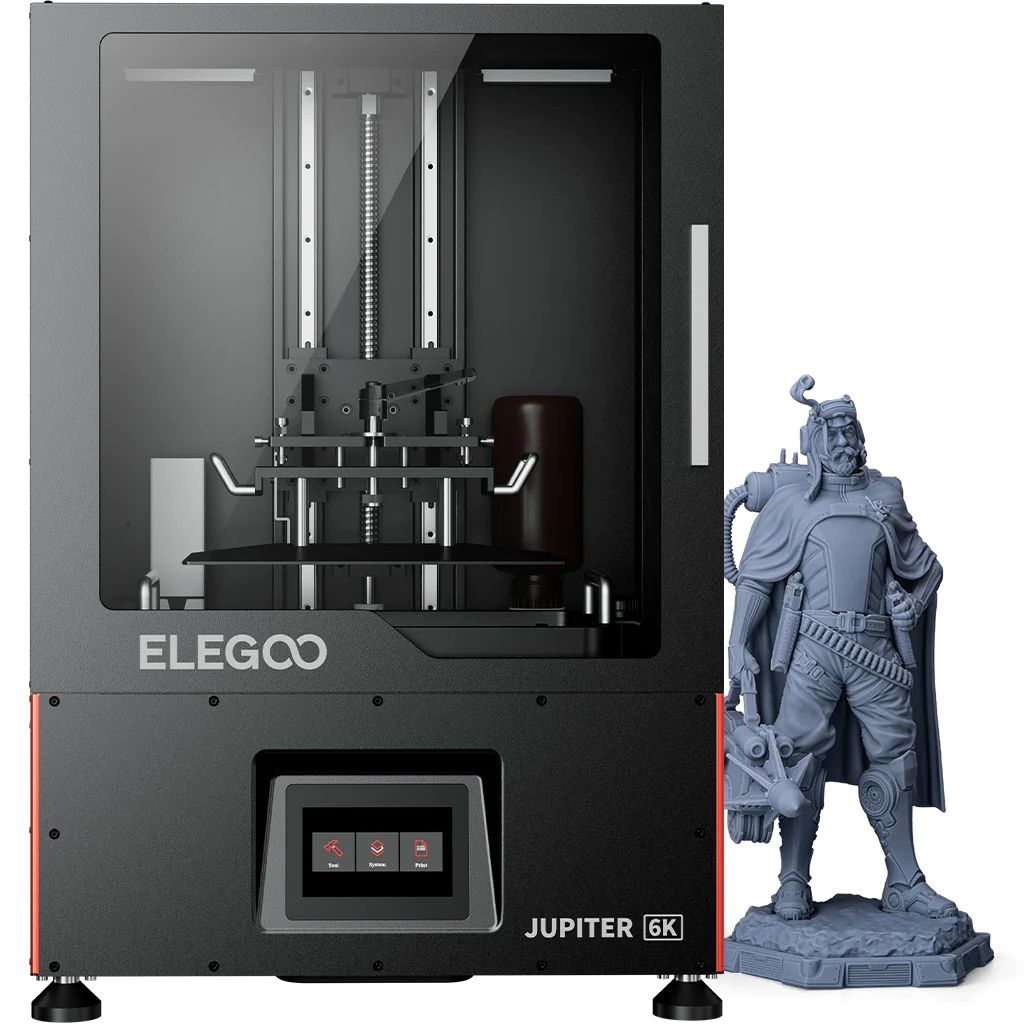
Elegoo Jupiter 6K
Premium pick
Ideal for props
$890 $1300 Save $410
For those making large props or sculptures, the Elegoo Jupiter 6K’s scale is ideal. But, it takes up plenty of space, is heavy, and isn’t especially cheap. It is not the best printer for small, detailed parts, but it is perfectly specified for more substantial prints.
- Big print volume
- Resin feeder system
- Sturdy construction
- 2,000-hour LCD life
- Only 51-micron voxels
At nearly 77 pounds, the Jupiter 6K isn’t a printer that most people will be moving much after they’ve unpacked it. However, the all-metal construction and advanced feature set more than offset the space it takes up. It also sports a print volume of 278 x 156 x 300mm, enabling some substantial prints to be generated. The flip side of prints that big is the amount of resin they can consume, and the Jupiter 6K addresses that issue with an automated resin feeder. Given how much resin is needed to fill the vat, that feature is more of a necessity than a nice-to-have.
Many have questioned a design where the screen is only 6K, where smaller printers have 12K and even 14K panels. The 6K screen gives the Jupiter 6K a relatively large voxel size of 51 microns, much greater than the 19 and 24-micron prints on smaller printers. Therefore, this machine represents a trade-off between print quality and part sizes. It should also be noted that a replacement screen, needed after around 2,000 hours of printing, costs $179.
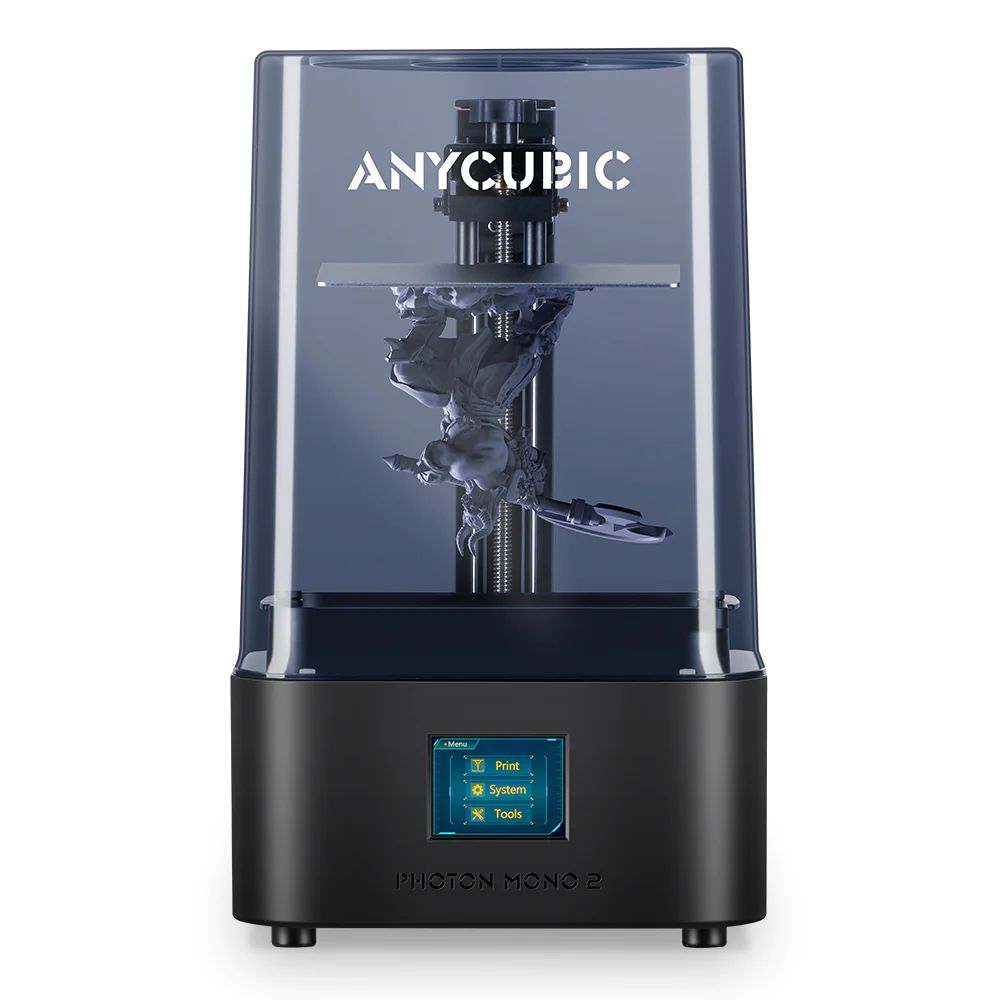
Anycubic Photon Mono 2
Best value
Cheap but effective
$179 $209 Save $30
The Anycubic Photon Mono 2 is the perfect initial choice when venturing into resin printing for the first time. Using a 4K resolution 6.6-inch LCD and with LightTurbo matrix for illumination, the output is detailed, and the cost won’t break the bank.
- Highly affordable
- Decent print quality
- Small print volume
- 2,000-hour life of display
This printer has recently increased in price by $10, but it still represents terrific value for anyone wanting to start their resin printing journey. With a modest 165 x 89 x 143mm (HWD) print volume, the Anycubic Photon Mono 2 is still large enough for game characters and modeling projects, and its 6.6-inch 4K screen generates crisp output with 34-micron square voxels. Cheaper printers can be found by other brands but don’t often have a 4K panel or some of the more desirable features that Anycubic includes the Mono 2, like a laser-etched build plate.
To make the required price point, the makers have used plenty of plastic and not metal in the construction, but it has metal where it needs to be, critically. Shipping with an Anycubic branded slicer, Photon Workshop V3, it also works with Lychee Slicer and the latest release of Chitubox for those familiar with them.
The best things about the Mono 2 are its initial low cost, and the replacement LCD panels are only $40, which you will need after approximately 2,000 hours of printing.
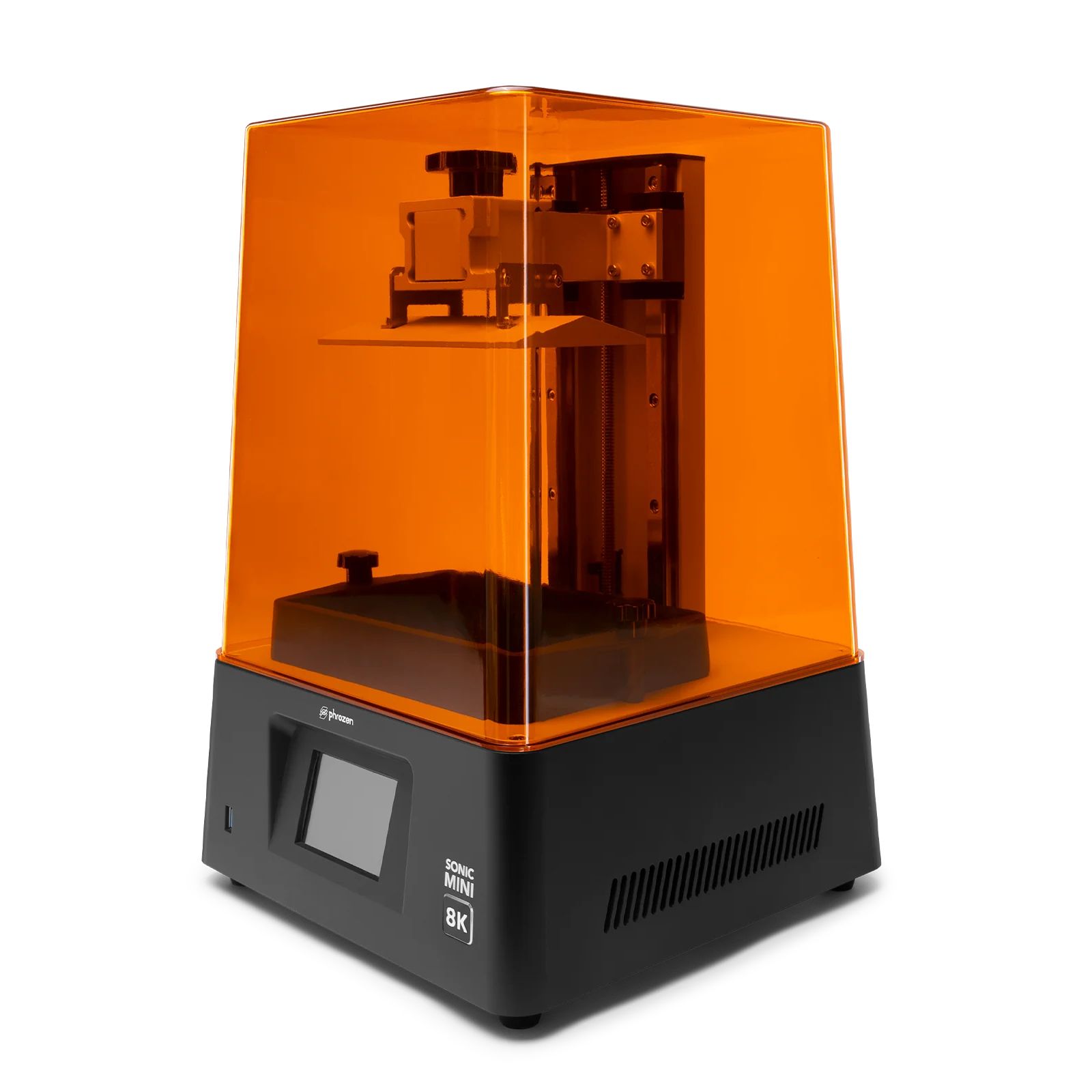
Phrozen Sonic Mini 8K
Perfect tabletop for figures
The Phrozen Sonic Mini 8K has a small print volume but a remarkably high 22-micron X and Y resolution, making it perfect for printing small figures and jewelry for resin casting.
- High-resolution printing
- Easy set-up
- Laser-etched print plate
- Expensive
- Only 7.1-inch LCD
The Phrozen Sonic Mini 8K has a 7.1-inch panel, slightly larger than the entry-level 6-inch resin printers, and the medium-format machines use 8 inches or larger. With a relatively small LCD panel but an 8K resolution, volex size is an impressive 22 microns. That high resolution, combined with aliasing, makes the Sonic Mini 8K the obvious choice for those using casting resin to make jewelry. Parts made on this printer require the minimum amount of preparation before being immersed in casting plaster.
This design is also quite power efficient, comes pre-calibrated, and offers a vertical print speed of 80 mm/hour, which is quicker than most in this slice of the market. One complaint about this design is that the build plate’s surface texture can make removing prints a challenge. The best solution for this problem is a magnetic build plate, and Wham Bam Systems has one sized for the Phrozen Sonic Mini 8K for $40. The LCD panels used by the Sonic Mini 8K also cost $105, plus another $5 for mounting tape. These last approximately 2,000 hours of use under normal circumstances.
It is unsuitable for prop making due to the small print volume, but for those wanting to make an Orc army or a platoon of sci-fi marines, the Phrozen Sonic Mini 8K is a strong option.
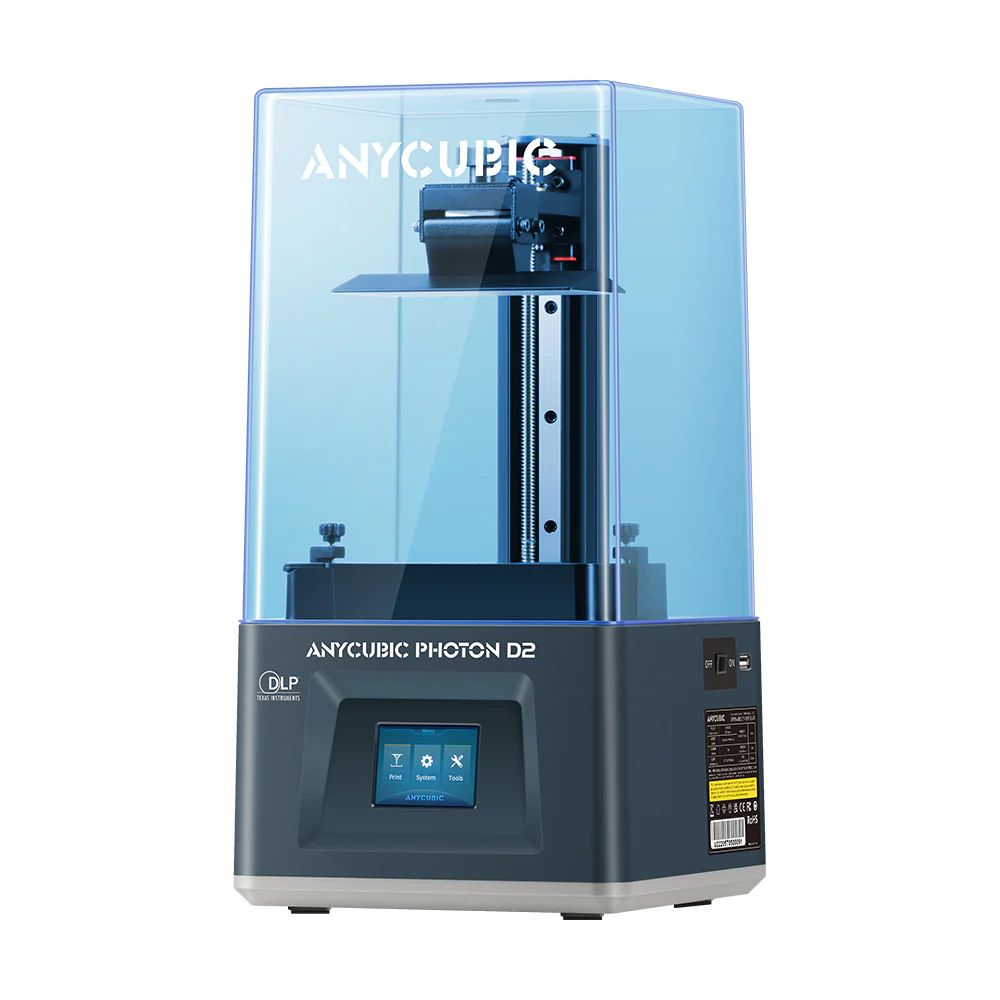
Anycublic Photon D2
A DLP option
Will have a long life
$349 $679 Save $330
Being a DLP printer, the Anycubic Photo D2 offers a few advantages over traditional SLA designs that make it useful for those producing resin parts in volume. With a lifespan tenfold the typical print life of LCD panels, the DLP technology reduces power consumption and machine wear.
- DLP (Digital Light Processing)
- 20,000-hour projector life
- Low power consumption
Where most resin printers use SLA technology, where light is projected through an LCD panel to expose each layer to the resin in the vat, the Anycubic Photo D2 uses an entirely different method called DLP (Digital Light Processing). There is one compelling advantage to DLP, and that’s the lifespan of the projector. Where SLA printers often quote a 2,000 or 3,000-hour life for the LCD panel, the Texas Instruments DLP projector of the Anycubic Photo D2 is rated for ten times as long.
It also uses much less power, as a machine of the same size using an LCD would typically use 50W, and this uses only 15W.
The flip side to these economic advantages is that the resolution is what resin printers were offering three years ago, not what they generally do today, making the output appear less crisp. It uses a special aliasing method to help with the 2560 x 1440, which is below other resin printers covered here. Therefore, the Anycubic Photo D2 is best suited to simple output that doesn’t need lots of detail, and buyers should know that it doesn’t come with some of the newer technologies, like resin feed or integrated air scrubbers.
With so few DLP printers around, we felt duty-bound to include one, but this is a resin printer for a very particular market and not for everyone.
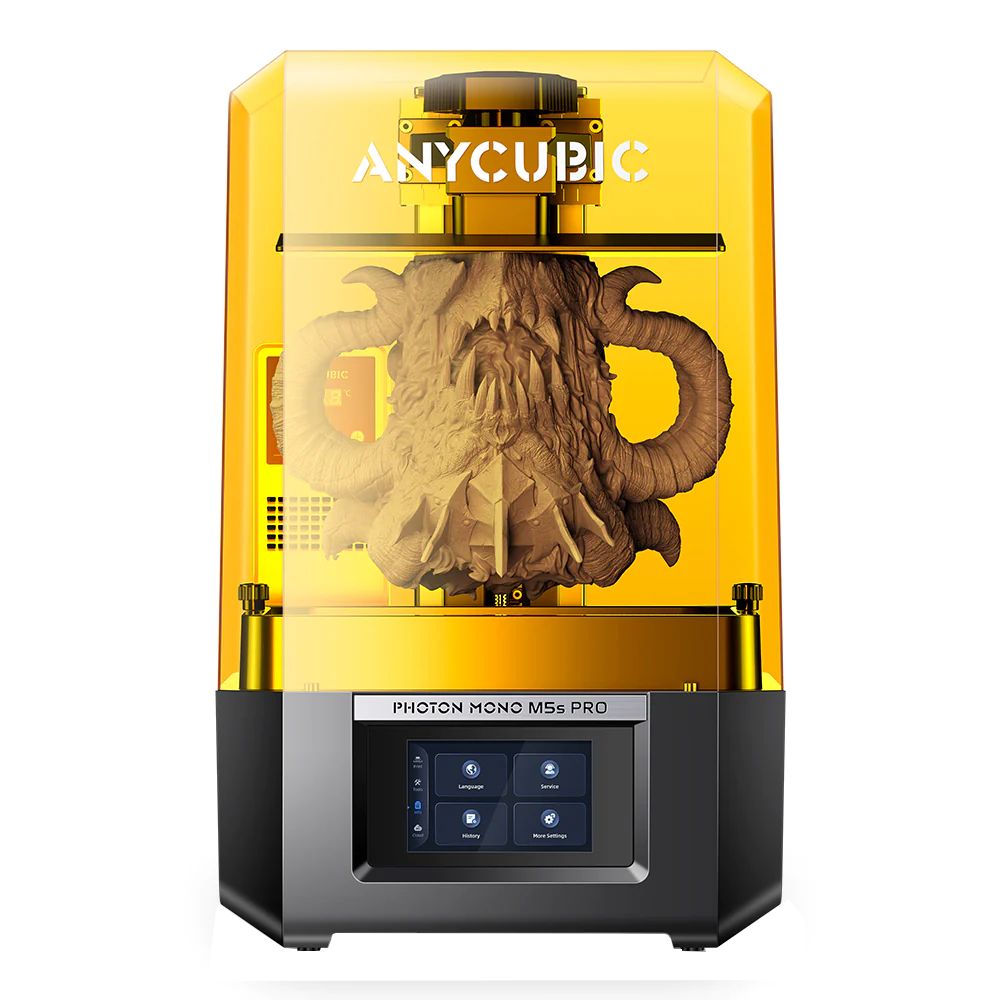
Anycubic Photon Mono M5s Pro
Feature-filled option
Great model in most respects
$479 $579 Save $100
A new version of the Anycubic Photon Mono M5s, the Pro model, has a heating system that should make failed prints much less likely in colder climates. Using a 14K screen and supplied with a heater and air purification onboard, this is the premium end of Anycubic’s medium-sized range.
- 14K LCD
- Resin Management
- Air filtration
- LCD lasts 2,000 hours
- Expensive screen to replace
Many will think that this printer is just a variant of the M5s built to address a different layer of the same market. But the Anycubic Photon Mono M5s Pro is different in so many ways from its M5s brother that it should be considered a new design. Compared to the M5s, the M5s Pro has a higher resolution 14K screen, better light uniformity, and a greater print volume. On the M5s, air purification was an option, but now, with the M5s Pro, it is standard, and so is a heater to bring the machine and resin to optimal temperature before each print. That feature makes the M5s Pro more suitable for use in the Northern Hemisphere, where keeping the process above 25C in winter can be difficult for at least six months each year.
The justifications for this printer over something like the Saturn 3 are that heater, Wi-Fi file transfers, and even greater detail levels. The voxels on this printer are rectangular, making them 16.8 in the X and 24.8 microns in the Y direction. It can also work with high-speed resins for those wanting faster printing while sacrificing some quality.
If this machine has a weakness, it’s that the 14K LCD is unlikely to be a cheap replacement when Anycubic finally lists it on their accessory pages.
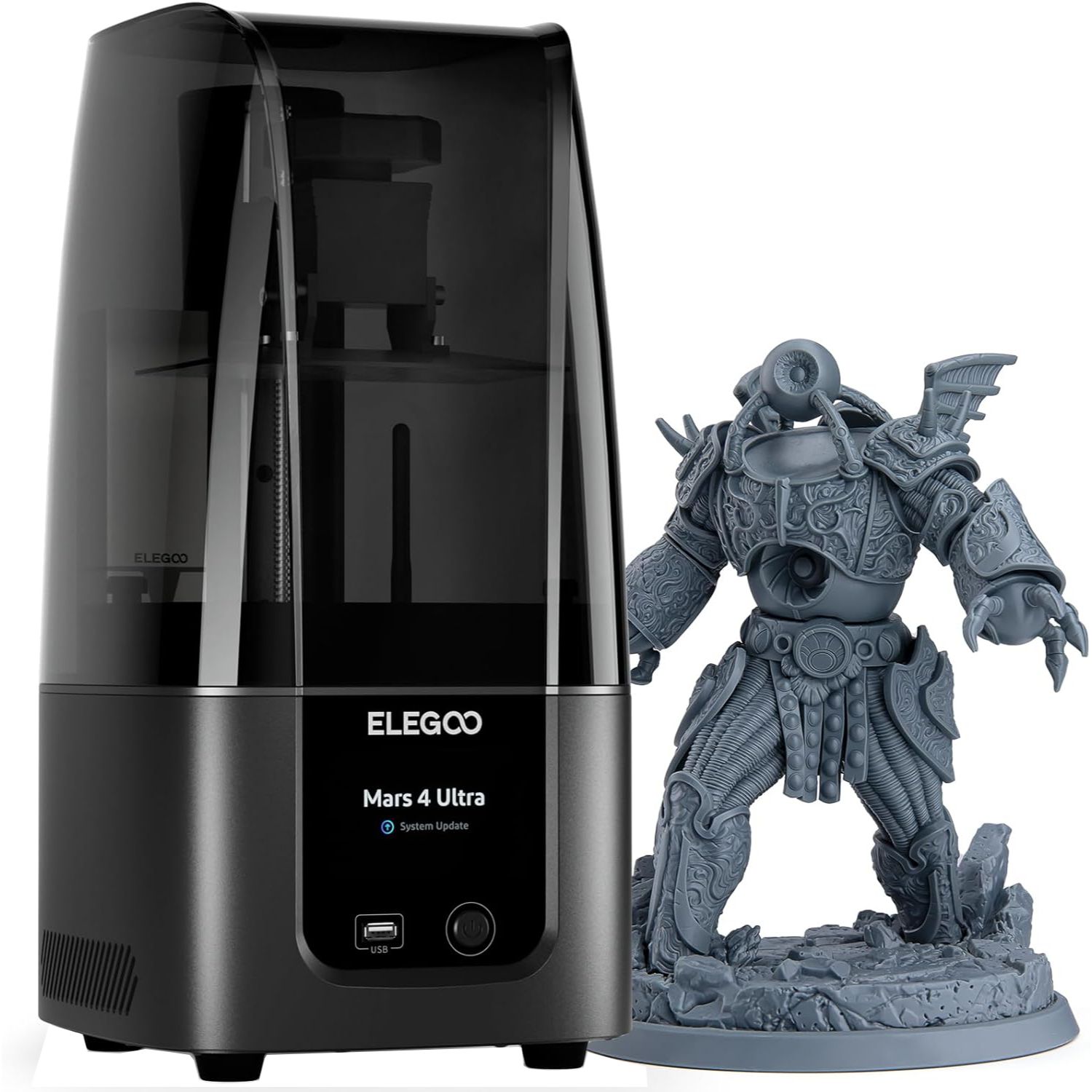
Elegoo Mars 4 Ultra 9K
Excellent figure printer
Small volume but high detail
$269 $330 Save $61
The Elegoo Mars 4 Ultra 9K is an entry-level resin printer that can produce highly detailed figures in its relatively small build area. An evolution from the original Elegoo Mars, the latest version features a 9K screen and a Linux operating system.
- 9K LCD
- Wi-Fi
- Attractive price
- LCD lasts 2,000 hours
- Small print volume
The original Mars by Elegoo was a straightforward machine that became popular because it was cheap and produced reliable output. The Elegoo Mars 4 Ultra 9K retains a similar styling to the previous Mars machines, but it’s now packed with top-end features, like Wi-Fi and a high-speed printing mode.
But Elegoo shifts many of these because of the 7-inch 9k screen with a natural resolution of 8520 x 4320, capable of generating a tiny voxel size of only 18 microns. Prints created on the Elegoo Mars 4 Ultra 9K are super-sharp and require minimal post-print processing. It also now comes as standard with an air filtration system, reducing the impact of using resin on the working environment to a more manageable level.
If you have figures or objects that fit into the 153.36 x 77.76 x 165mm print volume, the Elegoo Mars 4 Ultra 9K can produce output to rival the best medium resin printers, if not exceed them. This printer has great build quality, is highly reliable, and produces excellent results.
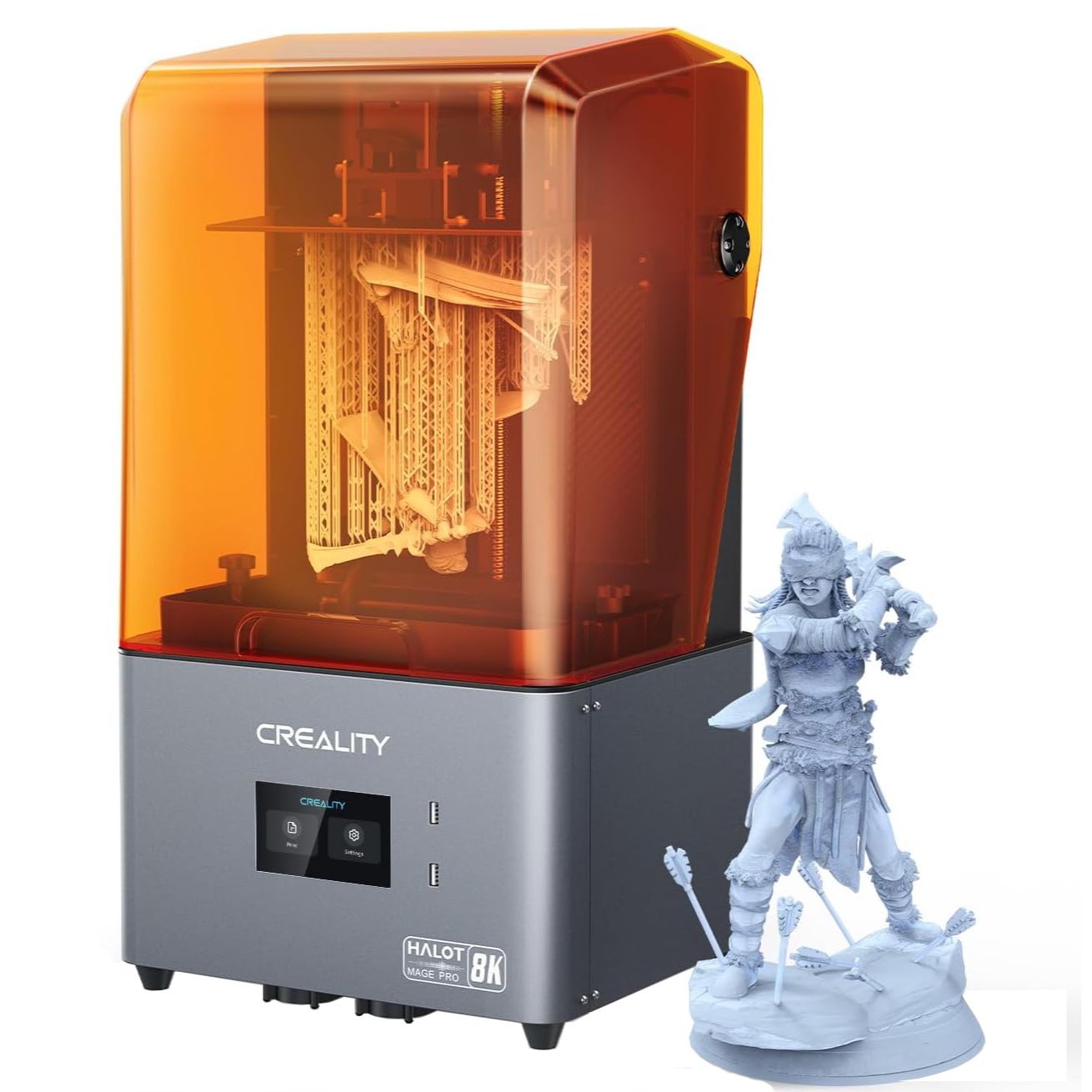
Creality Halot-Mage Pro 8K
Speed demon
Sacrifices quality for speed
$509 $599 Save $90
A medium-format resin printer from Creality, the Halot-Mage Pro 8K offers a 10.3-inch display for a decent print volume and many special features. The Halot-Mage has a resin pump on the can to keep the vat amply supplied and empty it when required.
- Great build quality
- Resin Management
- Air filtration
- LCD lasts 2,000 hours
- Only an 8K screen
Creality is better known for filament printing, but they have a small resin printer range, and the best on offer is the Halot-Mage Pro 8K. First launched in August 2023, this medium-sized resin printer uses SLA technology with a 10.3-inch 8K display (7680 x 4320), enabling a print volume of 228 x 128 x 230mm (6712cm³). It’s slightly vertically shorter and narrower than the Elegoo Saturn 3 12K, but the print width is marginally longer.
With other brands using 12K and 14K screens, these outclass the Halot-Mage Pro in terms of voxel sizes, with the best it can achieve being 29.7μm. Therefore, this isn’t ideal for hyper-detailed parts, but it’s okay for cosplay props and has an ultra-speed option to churn out parts at up to 170mm vertically every hour.
The Halot-Mage Pro takes less criticism for its robust construction quality, integrated resin pump for filling and de-tanking, and smart air purifier. Overall, considering that Creality makes only a tiny number of resin printers, the Halot-Mage Pro 8K is a stylish and well-considered design packed with useful features and can print rapidly. It’s not as cheap as some comparable designs, but it’s still worth consideration.
Which resin printer is best for your needs?
Any choice you make about a 3D printer needs to start with the intended use and what features are vital to achieve those objectives. But the best overall 3D printer for resin is the Elegoo Saturn 3 12K, as it offers unbeatable features balanced against the cost of ownership and ease of use. There are printers with higher quality or larger print volumes and other useful features like WI-Fi connections and resin management. But the Saturn 3 is a medium-format printer with a 12K resolution mono display that can produce exceptionally high-quality prints rapidly for a modest cost increase.
But if you only want to print small figures and sculptures, the Saturn 3 is overkill, and some money can be saved by choosing a less ambitious option like the Anycubic Photon Mono 2. It has a 165 x 89 x 143mm print volume, so it’s big enough for producing role-playing characters and terrain. With a smaller print volume, the amount of resin the vat holds is also less, making de-tanking and other cleaning exercises less of a chore. Critically, the voxel size of the Anycubic Photon Mono 2 is exceptionally small, resulting in the best print quality.
If the scale of prints and not quality is the priority, the Elegoo Jupiter 6K is ideal if you can accept the high purchase price. Its massive 278 x 156 x 300mm print volume is perfect for crafting larger sculptures and props, and a resin feeding system helps avoid running out during a big print. Just prepare to spend a lot on resin and the LCD screen when it needs replacing.
The cost of replacing LCD panels is one of the issues that blights most of the printers that use SLA technology on this list. The LCD panel used to mask each layer typically has a lifespan of around 2,000 hours of total use. When the panel eventually becomes degraded, the replacement cost can be a decent percentage of the price of a new printer. If mass production is your intention, then a printer that uses DLP and not SLA printing, like the Anycublic Photon D2, might be more suitable. But this technology costs more, and it doesn’t offer the quality of the best SLA printers.
Resin printer makers are continually launching new machines, so it’s worth visiting maker websites to see what new designs are available.

Elegoo Saturn 3 12K
Best overall
Medium-volume workhorse
$369 $450 Save $81
The Elegoo Saturn 3 is a mid-sized resin printer with a 10-inch 12K mono screen that allows a resolution of 19×24μm for remarkably crisp prints and short exposure times. Developed from the original Elegoo Saturn and Saturn 2s, the Saturn 3 is the perfect companion for artists who need a reliable workhorse printer.
Source link

